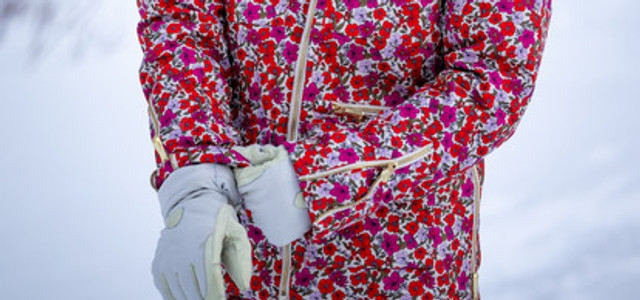What are the Best Ski Gloves?
Posted by Peter Glenn Staff on Sep 22nd 2025
Table of Contents
The Short Answer: Different ski scenarios require different types of gloves, from heavily insulated best ski gloves for coldest days to lightweight designs for warmer days. The best glove choice depends on your specific needs; considering factors like weather conditions, cold conditions, and skiing style.
Finding the right ski gloves can make or break your day on the slopes. At Peter Glenn Ski & Sports, we've helped countless skiers match their gloves to their skiing needs, with top brands like Black Diamond, Swany, and Gordini in our collection. Our decades of winter sports expertise means we understand how different gloves perform across various conditions and activities.
What to Look For in the Best Ski Gloves
Shell Materials
Ski glove shells come in two main varieties: goatskin leather and synthetic material. Leather gloves offer excellent durability and mold to your hands over time, making them a favorite among ski professionals. While they need regular waterproofing maintenance, leather gloves provide better grip and long-lasting performance. Synthetic gloves, made from nylon shell or polyester, require less maintenance and dry faster. Many modern designs combine both materials, using leather palms for grip and synthetic materials on the back of the hand for better moisture control.
Insulation Types
Most ski gloves use synthetic insulation like Thinsulate, which performs well even in wet conditions. The amount of insulation is measured in grams, typically ranging from 60 to 170 grams. Higher numbers mean warmer gloves, but also less flexibility. Lightweight gloves work well for spring skiing or high-intensity activities, while heavy-duty gloves suit cold conditions. Some gloves feature removable liner systems for temperature control and faster drying between uses.
Waterproofing Features
Water resistance comes from multiple layers working together. Gore-tex membrane provides reliable waterproofing while allowing moisture to escape. Many gloves use alternative waterproof membrane systems like BD.dry or brand-specific technologies. The outer shell usually has a DWR (durable water repellent) coating that makes water bead up and roll off. Leather gloves need regular treatment with special conditioners or waxes to maintain their water resistance.
Design Elements
The style of cuff affects how your gloves work with your jacket. Gauntlet-style cuffs extend over your jacket sleeve, offering extra protection from snow but adding bulk. Under-cuff designs tuck inside your jacket for a sleeker look and better mobility. Many gloves include features like wrist cinches to seal out snow, removable liner straps to prevent loss, and textured palms for better grip on ski poles. Some models add zippered pockets for hand warmers or venting on warmer days.
Best Ski Gloves by Skiing Scenario
Coldest Weather Options
For the coldest days on the mountain, the Hestra Heated Gauntlet Glove stands out. This insulated ski glove is breathable yet warm; it features heated panels on the fingertips and thumb to provide adjustable warmth low, medium, and high settings so you can change the heat to your needs. For maximum heat retention, mitts work better than gloves, though they limit finger movement.

Resort Skiing
Downhill skiing demands ski gloves that balance warmth, water resistance, and control. The Hestra Army Leather Patrol Glove provides moderate insulation, a waterproof membrane, and a leather material with palms that have better grip on ski poles. The glove has gauntlet-style cuffs that extend under jacket sleeves to block snow and provide a comfortable fit.
Wet Conditions
The 686 GORE-TEX Smarty 3-in-1 Gauntlet Glove excels in wet conditions with its Gore-Tex membrane providing reliable waterproofing. Synthetic insulation is preferable to down in damp conditions since it maintains warmth when wet. Key features include sealed seams, water-resistant synthetic material, and moisture-wicking liners that help hands stay dry from the inside out. Additionally, it includes a nose wipe and a heat pack pocket, providing extra luxury.

Backcountry Use and Spring Skiing
Backcountry skiing requires breathable gloves that prevent overheating during climbs while providing protection on descents. The Gordini Fall Line Glove features a moisture-wicking lining that swiftly removes sweat for maximum comfort. The design emphasizes ventilation and moisture management for high-output activities.
Similarly, spring days call for lightweight ski gloves with good breathability. Look for options with removable liner systems that allow for temperature regulation. Thinner synthetic gloves work well, and some include zippered vents for cooling.
Care and Maintenance
Leather Care
Leather ski gloves need regular attention to maintain their water resistance and durability. Apply leather conditioner before each season starts and again midway through heavy use. For waterproofing, use products like Sno-Seal or Nikwax, warming the leather gently with a heat lamp or in sunlight to help the treatment absorb deeply. Never dry leather gloves with direct heat sources like heaters or fireplaces, as this can crack the material.
Proper Storage
After each ski day, remove liners from gloves with removable liner systems and dry them separately to prevent moisture buildup. Store gloves hanging or laying flat in a cool, dry place - avoid cramped spaces or compressed storage. Between seasons, clean gloves thoroughly and store them in a breathable bag with silica gel packets to control moisture. For gloves with Gore-Tex membrane inserts, store the pieces separately to maintain their shape.
Extending Lifespan
Check seams and palm areas regularly for wear, especially on leather sections. Address small tears or loose stitching immediately to prevent bigger issues. Keep hook-and-loop closures clean and free from snow and debris. Replace gloves when waterproofing treatments stop being effective, or when you notice consistent wet conditions developing. Most quality ski gloves should last 2-3 seasons of regular use with proper care, though leather models often last longer.
For synthetic gloves, reapply water-repellent treatment when you notice water stopping beading on the surface. Clean dirty spots with gentle soap and lukewarm water, then air dry completely before using. Never machine wash insulated ski gloves as this can damage waterproof membranes and compress synthetic insulation.

Stay Warm with Peter Glenn
We’ve learned that ski gloves are instrumental to creating a great skiing experience. If your gloves are heavily insulated, you may sweat uncomfortably on a warmer day. However, if you opt for leather gloves, you may find yourself losing mobility on colder days. It is thus that having a wide array of gloves at hand will prepare you the most for any circumstance.
Whether you're tackling backcountry skiing adventures or cruising resort runs, at Peter Glenn, we offer leather gloves and synthetic gloves from trusted brands like 686, Kombi, Gordini, and Hestra to match every skiing scenario.
Our selection includes everything from ultra-warm mitts with waterproof membranes to lightweight synthetic gloves with removable liners. You'll find options with Gore-Tex membrane for wet conditions, goatskin leather palms for better grip, and heated gloves for those coldest days. Shop Peter Glenn today to find your perfect pair of ski gloves and get ready for your next mountain adventure.



